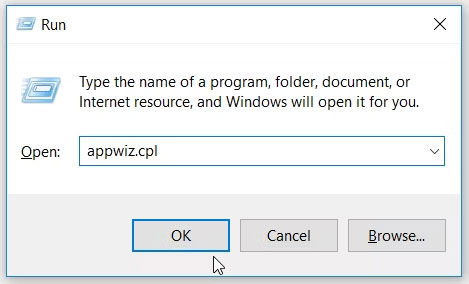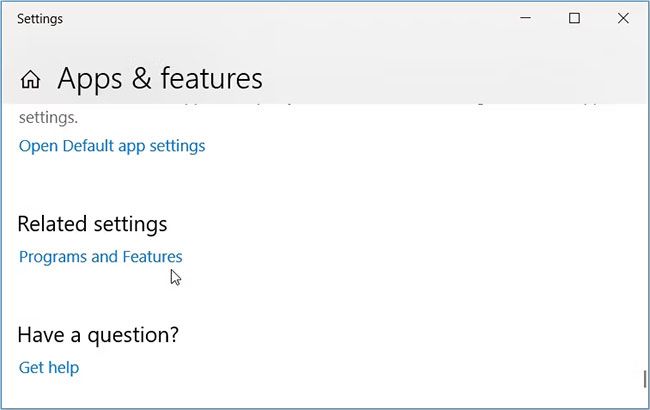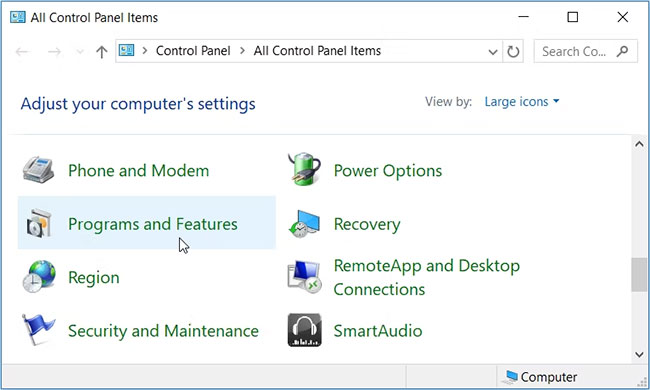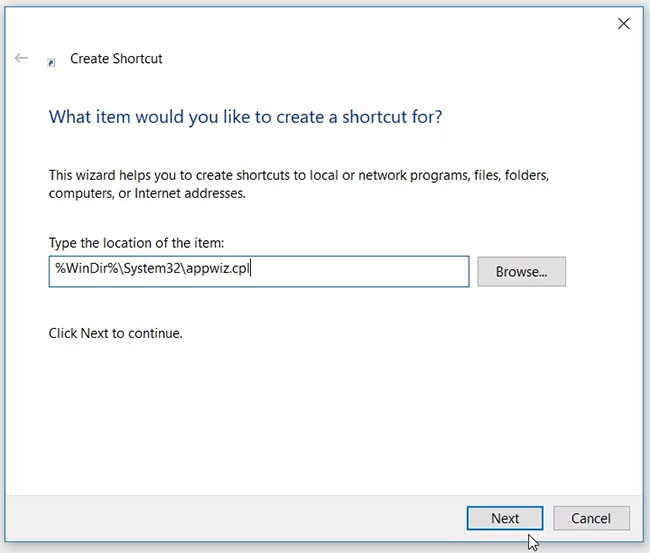8 ways to open Programs and Features tool on Windows
The Programs and Features tool shows you a complete list of applications installed on your PC. It helps you change, repair, or uninstall software programs in just a few simple clicks. But what are some quick and easy ways to access this handy feature?
To answer that, the following article will cover different methods to open Windows Programs and Features tool.
1. Use the Run command dialog box
You can access many Windows programs using the Run command dialog box. All you have to do is type the correct commands and you are good to go.
Now, here's how you can open the Programs and Features window using the Run command dialog box:
- Press Win + R to .
- Type appwiz.cpl and click OK to open the Programs and Features tool.

2. Use the Quick Access menu
The Windows Quick Access menu gives you easy access to most of the important apps on your device. Here's how it can help you open the Programs and Features tool:
- Press Win + X to open the Quick Access menu.
- In the next window, select Apps and Features .
- Finally, select the Programs and Features option under Related settings.

3. Use the Windows search bar
The Windows search bar makes it easy to find anything on your Windows device. Here's how you can use it to open the Programs and Features tool:
- Click the Start menu search bar and type Programs and Features .
- Select the Programs and Features option from the most relevant results.
4. Using Control Panel
If you want to easily open the Programs and Features tool, try using the Control Panel. Here are the simple steps to do it:
- Press Win + R to open the Run command dialog box.
- Type Control Panel and press Enter.
- Click the View by drop-down menu and select Large icons.
- Scroll down and click on the Programs and Features option .

5. Using Command Prompt or PowerShell
Command Prompt and PowerShell can be useful in some situations, such as troubleshooting system problems. These tools can also help you open different programs on your Windows device.
Let's explore how you can open the Programs and Features window using Command Prompt or PowerShell. To start, let's see how Command Prompt can help:
- Press Win + R to open the Run command dialog box.
- Type CMD and press Ctrl + Shift + Enter to .
- Type appwiz.cpl and press Enter to open the Programs and Features window.
Alternatively, try using PowerShell by following these steps:
- Press Win + R to open the Run command dialog box.
- Type PowerShell and press Ctrl + Shift + Enter to .
- Type appwiz.cpl and press Enter to open the Programs and Features window.
6. Using File Explorer
You can also access the Programs and Features tool using File Explorer. Here's how:
- Press Win + E to .
- Click This PC on the left pane.
- Click the Computer tab towards the upper left corner of the screen.
- Select Uninstall or change a program from the options.

7. Open via System Settings
System settings always come in handy when you are facing some system related issues. But in this case, this article will show you how these settings can help you open the Programs and Features tool.
- To start, press Win + I to .
- Navigate to Apps > Apps & features .
- Finally, click on the Programs and Features option on the right-hand side.
8. Create shortcuts for Programs and Features
You can also create a shortcut that gives you quick access to the Programs and Features tool. To get started, follow these simple steps:
- Right-click an empty space on the desktop and select New > Shortcut .
- Type %WinDir%System32appwiz.cpl in the location box, and then click Next.

- Name the shortcut Programs and Features or something similar, and then click Finish.
- To easily access the Programs and Features tool, navigate to the Desktop and double-click the shortcut you just created.
Want a simple way to see a complete list of apps on your Windows device? Or do you need one of the easiest ways to remove unwanted programs on Windows? If so, try using the Programs and Features tool.
And if you are wondering how to open this tool, try any of the tips mentioned above.
You should read it
- Remove hidden software in Windows 7, not found in Control Panel
- How to Open XML
- 10 open-source code applications are highly appreciated
- Uninstall and delete programs in Open With in Windows 7
- Remove 'root' programs that haven't been uninstalled completely on Windows 7, XP
- How to Control Windows 8 Startup Programs
 6 mistakes to avoid when using Gmail at work
6 mistakes to avoid when using Gmail at work How to Label Locations on Google Maps for Quick Access
How to Label Locations on Google Maps for Quick Access How to Customize and Remove Apps from Android's Share Menu
How to Customize and Remove Apps from Android's Share Menu Sodas You Probably Didn't Know Existed
Sodas You Probably Didn't Know Existed Beautiful and impressive year-end party invitation ideas
Beautiful and impressive year-end party invitation ideas How to send live location on Instagram
How to send live location on Instagram